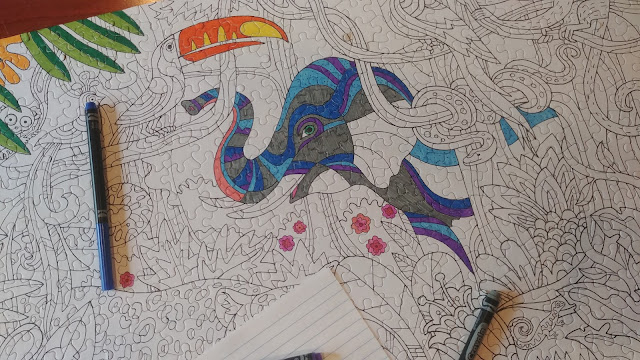One day of our family vacation by the lake, My Awesome Parents (MAP), Dear Husband, and I drove an hour from Lake Anna to Thomas Jefferson's estate, Monticello. I complained the whole way there that I was cold, and from the photo above you can still tell that the weather was initially grey and drizzly. However, by the time we had toured the mansion, the temperature had come up and the sun had come out, which is why so many of my photos ended up over-exposed and/or back-lit.
This is the view from the top of the "Little Mountain." I was impressed by the precautions taken to allow the historical site to re-open, including limiting the number of tickets and people allowed on the shuttle or inside the house. Masks were required, of course. Instead of guided tours, staff met visitors outside for short scheduled talks, and photographs inside are permitted for the first time. The only real disappointment was that we brought our own food for lunch, but the picnic area in the woods is closed, so instead of eating away from other people, we had to eat in the courtyard of the visitor center.
Above is his study, with a contraption on the table to write two copies of a letter simultaneously. To the right is the alcove where Jefferson slept, presumably after his wife died. Very efficient. Below are his copies of Don Quixote and a rotating clothes rack.

Dear Husband was particularly excited about this feature of the dining room he learned about in school: the wine "dumbwaiters" hidden on either side of the fireplace mantle.
Below is the tea room. Only the first floor of the mansion is open to visitors. After seeing it, we were just in time to grab seats under a tent on the lawn to hear a actor portraying the President give a little monologue and answer questions. He talked a lot about suffrage and leaned rather heavily on the idea that Jefferson would have expected society and laws to change over time to express support for the expansion of voting (e.g. to women, as the nation had just marked the anniversary of the 19th amendment). I thought it was a rather too-rosy feel-good retrospective interpretation of a man who pushed for religious freedom in Virginia but owned >600 human beings over the course of his life, including the mother of 6 of his 12 children, Sally Hemmings, who was half-sister to his wife, Martha. I learned that Sally accompanied him to Paris at the age of 14, was pregnant upon her return at 16, and negotiated freedom for her children...which was granted to the 4 who were still alive after Jefferson died on July 4, 1826. (The same day as John Adams.)
Above is the side of the building that Jefferson designed that you might recognize from the nickel. Below is a reconstruction of a slave cabin on Mulberry Row, with a view of the working garden the on-site cafe uses, and the valley beyond. There is also a memorial to the Jewish family who bought the estate after Jefferson died--$100,000 in debt for living beyond his means--and preserved much of it for posterity.
To the left is the ornate gate in front of Jefferson's obelisk, to the right, a view into the private family cemetery. Below are my favorite gravestones, which read "A perfect gentleman" and "A talented lady" on their back sides. Below that is the slave graveyard. More than 40 graves have been identified by careful digging, but none have been opened. Jefferson's family freed Sally Hemmings, and she lived the rest of her life in Charlottesville, but no one knows where she was buried.
To the left, DH sees how he measures up against Jefferson's 6' 2.5" stature. On the right, one of the two rooms historians think Sally Hemmings occupied with their children. It was a good trip, and I'm glad we went, but it does make you think where our priorities as a nation have been if schoolchildren have been taught about the architectural features of a Big House rather than the true nature of chattel slavery and the real reasons behind the Civil War. Hopefully with every generation we are doing a better job of handling our past.





































